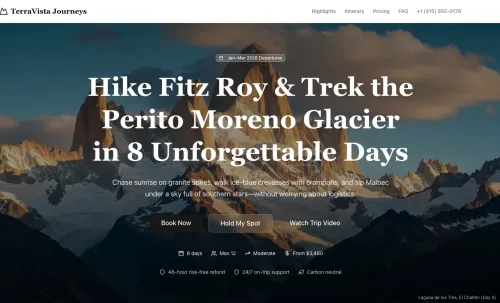✈️ The Complete Guide to Travel Landing Pages: Best Practices, Examples, and Conversion Strategies
In today's competitive travel landscape, a well-designed landing page can be the difference between a visitor bouncing and a customer booking their trip. This comprehensive guide explores everything you need to know about creating high-converting travel landing pages that drive real booking results.
Template Preview
See what your saas landing page will look like

What Makes Travel Landing Pages Unique?
Travel landing pages require a specialized approach that addresses the unique needs and decision-making processes of travelers, which is often emotional and high-investment. Unlike generic landing pages, travel pages must:
- Balance dreamy visuals with clear itinerary logistics.
- Build trust through relevant social proof and financial security assurances.
- Utilize scarcity (limited seats, limited-time offers) to drive immediate bookings.
Research shows that industry-specific landing pages convert 3-5x better than generic alternatives because they speak directly to the visitor's context (e.g., desire for adventure, relaxation, or cultural immersion).
Essential Elements of High-Converting Travel Landing Pages
1. Compelling Hero Section
Your hero section must immediately capture the visitor's imagination.
- Use stunning, large-format photography or video that showcases the destination's primary appeal.
- The headline should be outcome-focused and evoke emotion (e.g., "Escape to the Amalfi Coast: Your 7-Day Italian Dream").
- Prominently display the price and availability (e.g., "Only 8 Seats Left").
- Include a prominent Call-to-Action button (e.g., "Book Your Adventure Now").
2. Social Proof and Trust Signals
In the Travel industry, trust is paramount because clients are investing significant money and time. The most powerful forms of social proof for travel landing pages include:
- Customer testimonials with high-quality photos from the trip.
- Logos of travel associations (e.g., ABTA, IATA) or security badges.
- User statistics that demonstrate scale (e.g., "1,000+ Travelers Sent to Iceland").
- Testimonials that specifically mention the quality of accommodation, guides, or organization.
3. Clear Value Proposition (The Itinerary)
Your value proposition must answer: "Why should I book this trip over organizing it myself?" Focus on the unique benefits of the curated experience, ease, and exclusivity.
- Structure your value proposition around the itinerary: Use a scannable, day-by-day or section-by-section breakdown that highlights key experiences.
- Focus on outcomes and benefits: (e.g., Instead of "Day 3: Drive 3 hours," say "Day 3: See the Northern Lights from a private glass igloo.").
- Clearly detail Inclusions and Exclusions (e.g., What meals, flights, and transfers are covered?).
4. Strategic Call-to-Action Placement
Travel landing pages are typically longer due to the investment size, so CTAs must be repeated strategically.
- Include a primary CTA in the hero section for fast conversions.
- Add secondary CTAs after the itinerary breakdown and the pricing/inclusions section.
- Use urgent CTA copy: "Secure My Seat," "Book Now," or "Reserve for $200."
Conversion Optimization Strategies for Travel
Mobile-First Design
Over 60% of travel landing page traffic comes from mobile devices, where users often browse for inspiration. Design your page mobile-first, ensuring that:
- Image galleries and videos load quickly.
- CTAs are easily tappable.
- Forms are minimal and simple to complete.
Page Speed and Performance
Travel pages are media-heavy. Optimize all images and videos and use a Content Delivery Network (CDN) to minimize load times. Every second of delay reduces conversion rates by approximately 7%.
A/B Testing and Iteration
Continuously test and optimize your page, focusing on:
- Headlines (testing luxury vs. adventure vs. relaxation themes).
- CTA copy and placement.
- Pricing presentation (showing the total price vs. a "starting from" price).
- Urgency messaging (limited seats vs. limited time).
Common Mistakes to Avoid
Here are the most common pitfalls to avoid when building travel landing pages:
- Low-quality photos: Blurry or generic stock photos do not sell a high-value travel experience.
- Vague headlines: Don't just say "Mexico Trip"—be specific (e.g., "Oaxaca Culinary & Culture Week").
- Missing crucial details: Failure to clearly state the price, dates, and what is included/excluded.
- Hidden or confusing CTAs: Make the next step in the booking process crystal clear.
- No cancellation policy: Transparency on cancellation and refund terms is crucial for mitigating customer risk perception.
Measuring Success: Key Metrics for Travel Landing Pages
To optimize your travel landing page, focus on these Key Performance Indicators (KPIs):
| Metric | Definition | Typical Goal |
|---|---|---|
| Conversion Rate (Booking Rate) | The percentage of visitors who complete the payment/booking. | Aim for 2-4% (varies by price and traffic source). |
| Bounce Rate | The percentage of visitors who leave without interacting. | Aim for rates below 70%. |
| Time on Page | How long visitors spend on your page. | 90-120 seconds indicates strong interest given the content length. |
| Scroll Depth | How far down the page visitors scroll. | At least 60% of visitors should reach the itinerary and pricing sections. |
| Form Abandonment Rate | Track where visitors drop off during the multi-step booking form. | High abandonment suggests friction in the payment or required information fields. |
Getting Started with Your Travel Landing Page
Building a high-converting travel landing page doesn't have to take weeks. You can launch a professional, optimized landing page in hours by following these steps:
- Start with a proven template designed specifically for selling trips.
- Customize it with your high-quality destination photos and detailed itinerary.
- Add your social proof, testimonials, and clear trust signals.
- Optimize for mobile and speed.
- Launch with analytics tracking to measure and improve performance.
I have now processed all the landing page content provided. Let me know if you have any other files or requests.
Frequently Asked Questions
Ready to Create Your Travel Landing Page?
Start with our proven template and customize it for your business in minutes.
